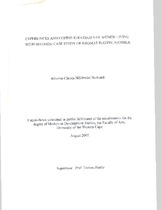| dc.contributor.advisor | Shefer, Tamara | |
| dc.contributor.author | Nashandi, Johanna Christa Ndilimeke | |
| dc.contributor.other | Institute for Social Development | |
| dc.contributor.other | Faculty of Arts | |
| dc.date.accessioned | 2013-07-10T08:53:34Z | |
| dc.date.available | 2007/04/18 13:27 | |
| dc.date.available | 2007/04/18 | |
| dc.date.available | 2013-07-10T08:53:34Z | |
| dc.date.issued | 2002 | |
| dc.identifier.uri | http://hdl.handle.net/11394/1624 | |
| dc.description | Magister Artium - MA | en_US |
| dc.description.abstract | This study focuses on the impact of HIV/AIDS on women in Namibia. Namibia, with a population of only 1.7 million people, is ranked as the seventh highest country in the world in terms of HIV/AIDS infections. The percentage of women living with HIV/AIDS in Namibia accounts for 54% of the total of 68 196 people in the country living with the virus. Women are also diagnosed with the disease at a younger age (30) in comparison to their male counterparts (35 years). Desoite their needs, women living with HIV/AIDS bear a triple burden of caring for those living with HIV/AIDS, caring for themselves and coping with the responses to their infection. There are few focused intervention strategies to support and care for women living with HIV/AIDS in Namibia. | en_US |
| dc.language.iso | en | en_US |
| dc.publisher | University of the Western Cape | en_US |
| dc.subject | AIDS (Disease) in women | en_US |
| dc.subject | Services for Namibia | en_US |
| dc.subject | HIV infections | en_US |
| dc.subject | HIV (Viruses) | en_US |
| dc.subject | Namibia AIDS (Disease) | en_US |
| dc.subject | Patients - Counseling | en_US |
| dc.subject | Care | en_US |
| dc.title | Experiences and coping strategies of women living with HIV/AIDS: case study of Khomas region, Namibia | en_US |
| dc.type | Thesis | en_US |
| dc.rights.holder | University of the Western Cape | en_US |
| dc.description.country | South Africa | |

